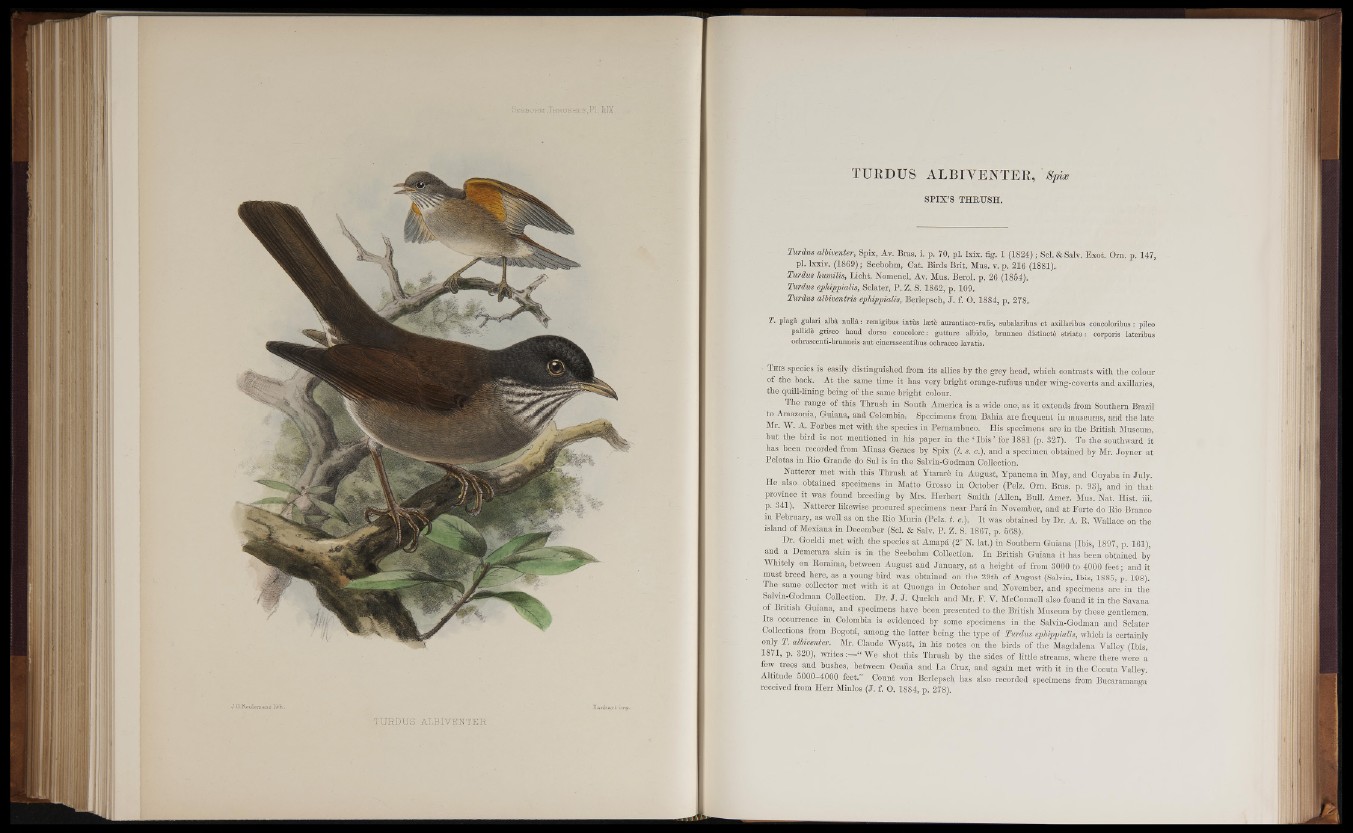
SjS'E.BOH M ,TH K U S H E S ,P 1 . IlIX.
H a n l i a r t im p .
rU R D U S A L B IV E N T E R .
TURDUS ALBIVENTER, ' Spiar
SPIX’S THRUSH.
Turdus alMventer, Spix, Ar. Bras. i. p. 70, pi. box. fig. 1 (1824); Scl. &Salv. Exot. Orn. p. 147,
pi. lxxiv. (1869); Seebohm, Cat. Birds Brit. Mus. v. p. 216 (1881),
Turdus humilis, Licbt. NomeffclfAv. Mus. Berol. p728 (1854).
Turdus ephippialis, Sclater, P. Z. S. 1862, p. 109.-
Turdus alUventris ephippmlis, Berlepsch, J. f. 0 . 1884, p. 278.
T. plagá gulari alb& m illá : remigibus intus laete aurantiaco-rufis, subalaribus et axillañbus concoloribua: pileo
pallidé gríseo baud dorso coneolore: gutture albido, brunneo distincté striato: corporis lateribus
ochrascenti-bnmneis aut cinerascentibus ochraceo lavatis.
> Phis species is easily distinguished from its allies .by the grey head, which contrasts with the colour
of the back. At the same time it has very bright orange-rufous under wing-coverts and axillaries,
the quill-lining being of the same bright colour.
The range of this Thrush in South America is a wide one, as it extends from Southern Brazil
to Amazonia, Guiana, and Colombia. Specimens from Bahia are frequent in museums, and the late
Mr. W. A. Forbes met with the species in Pernambuco. His specimens are in the British Museum,
but the bird is not mentioned in his paper in the ‘ Ibis ’ for 1881 (p. 327). To the southward it
has been recorded from Minas Geraes by Spix (I, s. c.), and a specimen obtained by Mr. Joyner at
Pelotas in Kio Grande do Sul is in the Salvin-Godman Collection.
Natterer met with this Thrush at Ytarare in August, Ypanema in May, and Cuyaba in July,
He also-obtained specimens in Matto Grosso in October (Pelz. Om. Bras. p. 93),. and in that
province it was found breeding by Mrs. Herbert Smith (Allen, Bull. Amer. Mus. Nat. Hist. iii.
p. 341). Natterer likewise procured specimens near Pará in November, and at Forte do Bio Branco
in February, as well as on the Bio Muria (Pelz. t. <?.). It was obtained by Dr. A. B. Wallace on the
island of Mexiana in December (Sd. & Salv. P. Z. S. 1867, p. 6 6 8 § 0
Dr. Goeldi met with the species at Amapá (2° N. lat.) in Southern Guiana (Ibis, 1897, p. 161),
and a Demerara skin is in the Seebohm Collection. In British Giiiana it has been obtained by
Whitely on Boraima, between August and January, at a height -of from 3000 to 4000 feet; and it
must breed here, as a young bird was,obtained on the 29th of August (Salvin, Ibis, 1885, p. 198).
The same collector met with it at Quonga in October and November, and specimens are in the
Salvin-Godman Collection. Dr. J. J. Quelch and Mr. F. V. McConnell also found it in the Savana
of British Guiana, and specimens have been presented to the British Museum by these gentlemen.
Its occurrence in Colombia is evidenced by some specimens in the Salvin-Godman and Sclater
Collections from Bogotá, among the latter being the type of Turdus ephippialis,which is certainly
only T. alhivmter. Mr. Claude Wyatt, in his notes on the birds of the Magdalena Valley (Ibis,
1871, p. 32Q), writes :—“ We shot this Thrush by the sides of little streams, where there were a
few trees and bushes, between Ocaña and La Cruz, and again met with it in the Cocuta Valley.
Altitude 5000-4000 feet.” Count von Berlepsch has also recorded specimens from Bucaramanga
received from Herr Minios. (J. f. O. 1884, p. 278).